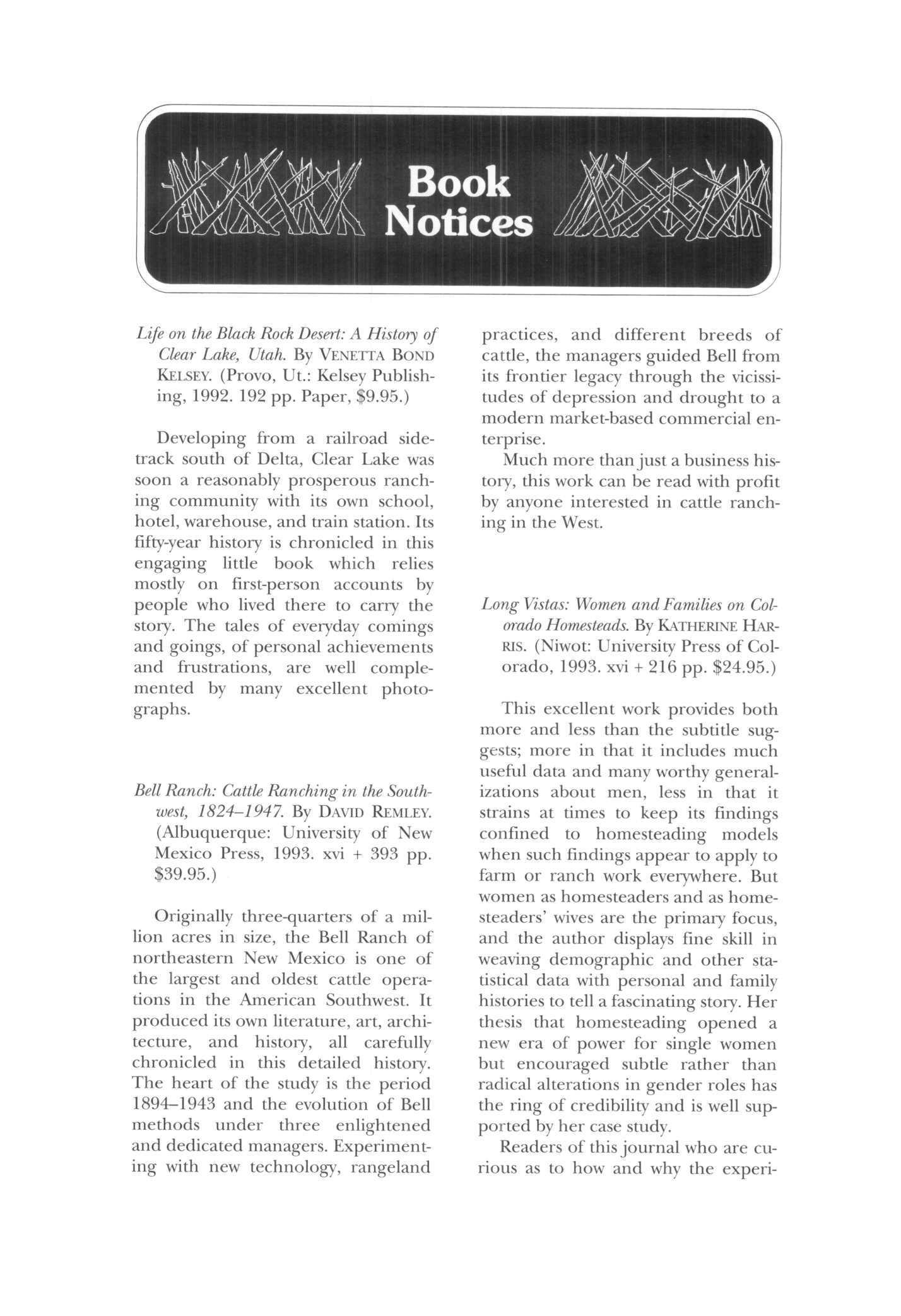
5 minute read
Book Notices
Life on the Black Rock Desert: A History of Clear Lake, Utah.
By VENETTA BOND KELSEY. (Provo, Ut.: Kelsey Publishing, 1992 192 pp Paper, $9.95.)
Developing from a railroad sidetrack south of Delta, Clear Lake was soon a reasonably prosperous ranching community with its own school, hotel, warehouse, and train station. Its fifty-year history is chronicled in this engaging little book which relies mostly on first-person accounts by people who lived there to carry the story The tales of everyday comings and goings, of personal achievements and frustrations, are well complemented by many excellent photographs Bell Ranch: Cattle Ranching in the Southwest, 1824-1947. By DAVID REMLEY (Albuquerque: University of New Mexico Press, 1993 xvi + 393 pp $39.95.)
Originally three-quarters of a million acres in size, the Bell Ranch of northeastern New Mexico is one of the largest and oldest cattle operations in the American Southwest It produced its own literature, art, architecture, and history, all carefully chronicled in this detailed history. The heart of the study is the period 1894-1943 and the evolution of Bell methods under three enlightened and dedicated managers Experimenting with new technology, rangeland practices, and different breeds of cattle, the managers guided Bell from its frontier legacy through the vicissitudes of depression and drought to a modern market-based commercial enterprise.
Much more thanjust a business history, this work can be read with profit by anyone interested in cattle ranching in the West.
Long Vistas: Women and Families on Colorado Homesteads.
By KATHERINE HARRIS. (Niwot: University Press of Colorado, 1993 xvi + 216 pp $24.95.)
This excellent work provides both more and less than the subtitle suggests; more in that it includes much useful data and many worthy generalizations about men, less in that it strains at times to keep its findings confined to homesteading models when such findings appear to apply to farm or ranch work everywhere. But women as homesteaders and as homesteaders' wives are the primary focus, and the author displays fine skill in weaving demographic and other statistical data with personal and family histories to tell a fascinating story. Her thesis that homesteading opened a new era of power for single women but encouraged subtle rather than radical alterations in gender roles has the ring of credibility and is well supported by her case study.
Readers of this journal who are curious as to how and why the experience of Utah women homesteaders differed from the national model generally will find Chapter 6 particularly interesting, and anyone who has ever looked at how women on the frontier have been treated in literature and history will appreciate the fine overview in the introduction.
The Architecture of Immigration: Documenting Italian-American Vernacular Buildings in Utah and Nevada.
By THOMAS CARTER (Salt Lake City: Graduate School of Architecture, University of Utah, 1992. 19 pp. Paper.)
Looking at Carbon County, Utah, and Eureka County, Nevada, the author and his graduate students have included drawings, photos, and narrative to support the thesis that the architecture of Italian immigrants displays variety and considerable distinction but has to be carefully looked for to be seen. This pamphlet is reprinted from the larger study, Old Ties, New Attachments: Italian-American Folklife in the West, published by the American Folklife Center in 1992.
Designedfor Work: The SanJacinto Ranch of Elko County, Nevada.
Edited by THOMAS CARTER and BLANTON OWEN (Salt Lake City: Graduate School of Architecture, University of Utah, 1993, 30 pp Paper.)
The Western Vernacular Architecture Program of the U of U's Graduate School of Architecture documented the San Jacinto Ranch near Jackpot, Nevada, in the summer of 1992 with measured drawings, photographs, and oral histories The result is this brief but attractive booklet, projected as the first in a series of similar projects.
Tall Sheep: Harry Goulding, Monument Valley Trader.
By SAMUEL MOON (Norman: University of Oklahoma Press, 1992. xviii + 250 pp. $24.95.)
Harry Goulding and wife Mike operated a trading post, located on the Utah-Arizona line in Monument Valley, from 1925 to 1963 A sharp observer of Navajo lifestyles and folkways, as well as an articulate story teller, Harry is the primary respondent in this predominantly oral history. Mike also chips in, as does a small cast of other local characters, including Barry Goldwater, in recounting experiences and observations of how New Deal stock reductions, World War II, uranium, and much else affected Navajo life Author Moon plays an important role as well, offering welcome interpretation and context along the way.
Anthropologists as well as historians will find much to value in the book, as the testimony includes tantalizing glimpses of Navajo child nurturing, folk medicine, and weather ceremonials. And Utahns generally will be surprised at the aggressive action taken byJ. Bracken Lee, not yet governor, in securing money to support schools in the area. "He was a tiger," Goulding recalled. "I think he had two tails!"








